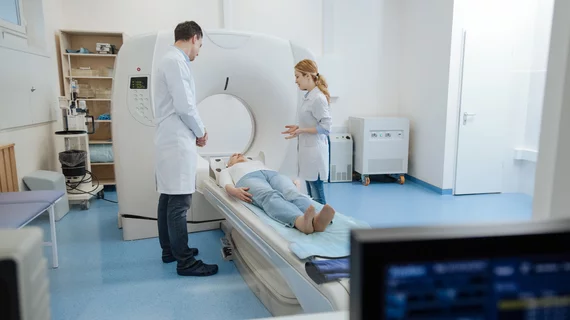Radiologists reignite debate over the specialty's role in monitoring contrast injections
Radiologists took to one of the field’s top journals a few months back to debate why imaging providers should, or should not, be required to monitor contrast administrations. And two authors recently reignited that conversation with a new editorial.
Andrew Wilmot, MD, of Brighton Radiology Associates, and Saurabh Jha, MD, with the Hospital of the University of Pennsylvania, who penned the original article on the topic back in March, said contrast duties should be discussed, but objections to their arguments are likely based on different perspectives.
For example, a large practice with 50 radiologists that sends two to cover outpatient sites will feel little impact on staffing levels. But for a group of 10 rads, having two oversee contrast injections each day becomes a thorny coverage issue, the Pennsylvania editorialists explained May 23 in JACR.
Additionally, the pair said Yale-New Haven Hospital physician Jeffrey C. Weinreb, MD, is coming at the debate from the wrong angle in arguing radiologists should be “careful what we wish for” before relinquishing these duties.
“Yes, let’s discuss outpatient contrast coverage,” Wilmot and Jha wrote in their response piece. “But let’s not base our position on fear of reimbursement cuts or insecurity about public perception. In this profession, nothing is certain except death, taxes, and reimbursement cuts.”
In his March 22 piece, Weinreb argued removing rads from outpatient centers may provide “fodder” for the idea these specialists don’t want to deal with patients and aren’t “real doctors.” But providers tasked with only overseeing injections may have no direct interactions at all. And if the public fails to see the crucial role of radiologists, “at a certain point that becomes more a reflection of the public than of us,” Wilmot and Jha wrote Monday in response to the Yale-New Haven doc.
Ultimately, the pair said they are attempting to put radiologists’ skills to maximal use. But that doesn't mean rads should step out of the contrast picture completely.
“If called upon, radiologists must do their utmost for patients with contrast reactions regardless of CMS policies—they just shouldn’t be stationed at every intersection,” the duo argued Monday.
Read more from the authors' editorial here. And you can access the original opinion piece here, as well as Weinreb’s response here.

